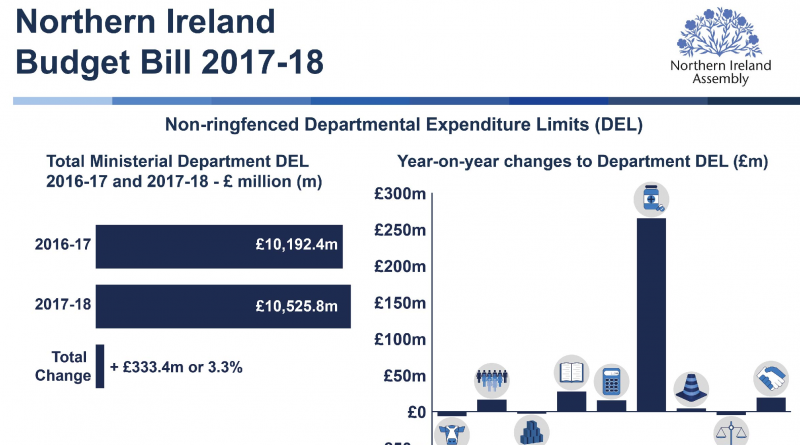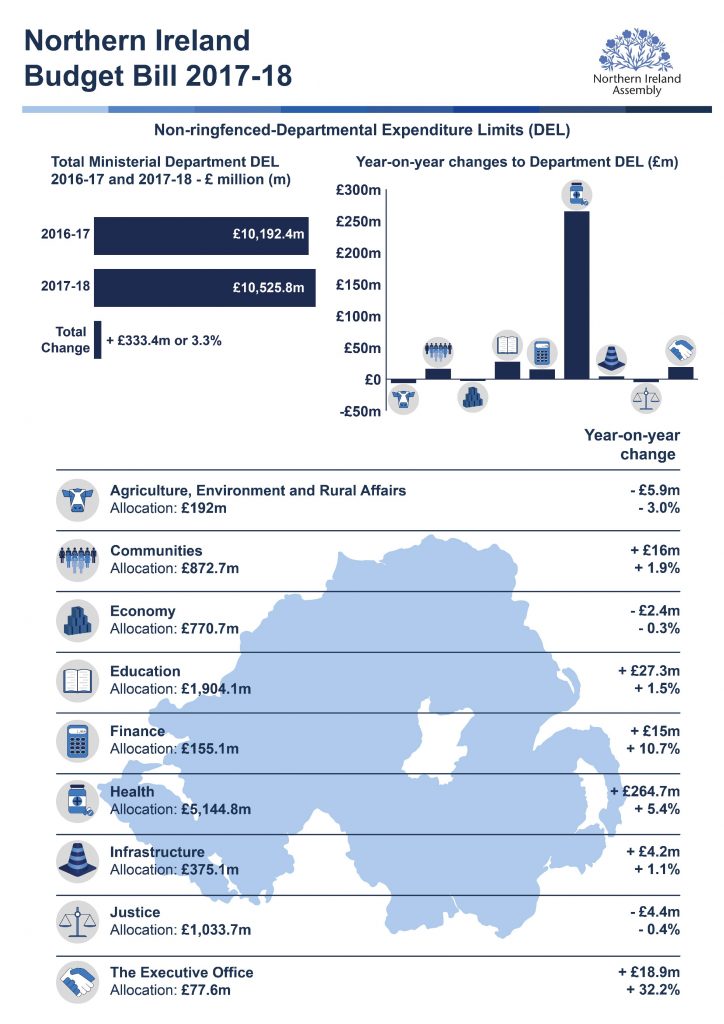Save Our Spending! What do we need to know about the Secretary of State for Northern Ireland’s 2017-18 budget?
This article examines the Budget Bill put forward today by the Secretary of State for Northern Ireland (NI) in Westminster.
The recent blog article Reclaiming the power of the purse explained the actions which the Secretary of State (SoS) for NI has taken to maintain public bodies’ ability to continue spending in the absence of an Executive Budget for 2017-18. The deadline he set for reformation of an Executive has now passed and Westminster has legislated for a budget for Northern Ireland.
What are key events leading up to the current NI Budget Bill in Westminster?
Jan 2017: Executive collapses and the Assembly ceases:
The Executive collapsed following a series of political events, and the Assembly ceased to exist.
Mar 2017: Assembly elections:
There was an Assembly election.
Mar 2017: No Executive formed:
Following the election, no Executive was formed within the statutory period under the Northern Ireland Act 1998. As a result, no NI Executive Budget was agreed for the 2017-18 financial year and no budget legislation could be brought forward in the Assembly.
Mar 2017: First time interim powers used to allow daily administration to continue in NI:
The NI Department of Finance (DoF) Permanent Secretary authorised to provide funding to NI departments under section 59 of the NI Act 1998, for 1 April 2017 up to July 2017; but for a maximum of 75 per cent of the NI Executive Budget for 2016-17, as stated in the Act.
Apr 2017: NI Secretary of State set out indicative budget for NI:
Based on advice from the Head of the NI Civil Service, the NI Secretary of State issued a written statement that set out an indicative budget position for NI and set departmental budget allocations.
Apr 2017: NI Secretary of State takes action to set regional rate:
Given the absence of government in NI, the Houses of Parliament enacted legislation brought forward by the NI Secretary of State, which set the NI regional rate, thereby enabling the rate to be issued, and subsequently providing for on-going finance to local government and departments in NI.
July 2017: NI Secretary of State takes action on the Budget for NI:
The NI Secretary of State issued a written statement adjusting the indicative budget positions and departmental allocations for the 2017-18 financial year set out by him in April. His Statement did not include the Democratic Unionist Party and the United Kingdom Government’s ‘confidence and supply’ agreement.
Aug 2017: Permanent Secretary powers used again:
The NI DoF Permanent Secretary now authorised to provide funding to NI under section 59 of the NI Act 1998, for 1 April 2017 up to the end of the financial year; but for a maximum of 95 per cent of the NI Executive Budget for 2016-17, as stated in the Act.
November 2017: NI Budget Bill in Westminster:
The NI Secretary of State announced that he will lay the Budget Bill 2017-18 for NI in the House of Commons, to ensure NI departments do not run out of money. He explained that the Bill will incorporate the figures provided by the NI Civil Service, reflecting its assessment of the outgoing priorities of the previous Executive. He further stated that the Bill will not include the money associated with the Democratic Unionist Party and the UK Government’s “confidence and supply” agreement agreed in June 2017.
What are key changes arising from this Budget?
The headline changes in the allocations to ministerial departments’ day-to-day spending (known as ‘Non-ringfenced Resource DEL’ (Departmental Expenditure Limits)) for 2017-18 are shown below in Figure 1 (below). There is a 3.3% overall increase in these day-to-day spending allocations across the Northern Ireland public sector.
These figures are most important to focus on when seeking to understand the Budget’s impact on daily service delivery; whilst still acknowledging that departments do also invest in assets, such as buildings roads and equipment, using their Capital DEL budgets.
It is important to note that the numbers in Figure 1 exclude the temporary impact of the Voluntary Exit Scheme (VES).
What is the VES?
The VES was agreed to allow Northern Ireland departments to use borrowed money to pay public servants to leave before retirement age. In the long run, it should enable public bodies to save money. The idea is that long-serving, and therefore expensive, members of staff are replaced with cheaper staff at the lower end of the pay scale, or not replaced at all. In the latter case, the work either has to be taken on by somebody else, or it has to cease.
The VES was initially announced in a statement on the Executive’s Budget 2015-16. The then Minister of Finance described it as part of a ‘workforce restructuring plan’, which would:
…embrace all possible personnel interventions including a recruitment freeze, suppressing vacancies, use of temporary staff, pay restraint and a voluntary exit mechanism to reduce workforce numbers.
VES funding was set out in the financial annex to in the 2014 Stormont House Agreement. This provision gave the Executive the:
…flexibility to use £700m of capital borrowing to fund a voluntary exit scheme over a period of 4 years with £200m in 2015-16, £200m in 2016-17, £200m in 2017-18 and £100m in 2018-19.
Excluding the VES figures from the figures stated in Figure 1 (above) enables a more accurate year-on-year comparison from 2016-17 to 2017-18: this is because VES spending was a ‘one-off’, occurring only once.
What else is notable about the 2017-18 Budget?
Below are a list of questions arising from this budget – the Non-ringfenced Resource DEL figures in particular – which are similar to those that the Assembly would ask about budgets when in operation:
- Health Spending
Health spending has broken the £5 billion barrier for the first time in Northern Ireland, with a 5.4% increase. This means that the Department of Health’s allocation for 2017-18 is 48.9% (i.e. very nearly half) of the ministerial departments’ total.
Of a total increase in allocations of £333.4 million across the ministerial departments, the Department of Health received £264.7 million, or about 80%. In other words, of the total increase in Northern Ireland’s day-to-day spending allocations for 2017-18, about four-fifths has gone to Health.
- Comparing spending from one year to the next tells a limited story
Ideally, to understand significant changes in public expenditure, it is useful to look at a longer period that a single year. This establishes trends over time. But Northern Ireland’s departments were reorganised in May 2016, reducing from 12 to nine. Functions were transferred from one place to another, along with the associated budgets. This means observers do not have comparable data over a time period.
- Inflation is beginning to rise
Earlier this month, the Bank of England raised the base interest rate to 0.5%. This decision was taken because of Consumer Price Index inflation, which was 3% in September 2017. Departments must manage their budgets within the cash that is allocated to them. Over time, rising inflation means those allocations will buy fewer services. It is uncertain how long it will take for the Bank of England’s decision to affect inflation.
- Executive borrowing costs money, and has to be repaid
The Budget Background document published today by the Department of Finance (DoF) includes a table on page 31. This shows that interest repayments will be £57.8 million in 2017-18. It is not possible to discern from that information as to how much of this repayment relates to the VES discussed earlier. Nor does the DoF’s document state how much has been saved so far through the VES. This makes comparisons and value-for-money assessments of the VES impossible.
- Assembly Spending
The Assembly is classed as a non-ministerial department. Its allocation for 2017-18 has reduced by 9.2% from £39 million to £35.4 million. This is a relatively large percentage reduction, but the Assembly’s allocation for 2017-18 remains above that of the Public Prosecutions Service – the second largest spending non-ministerial department.
- Capital investment
This article focuses on day-to-day spending. Today’s Budget for 2017-18 reveals very little change in Capital DEL budgets for infrastructure investments. See Table 1 (below):
| Department | 16-17 Total Capital DEL (£m) | 17-18 Total Capital Del (£m) | Year-on-year change (£m) | Year-on-year change (%) |
| Agriculture, Environment and Rural Affairs | 48.8 | 36.9 | -11.9 | -24.4% |
| Communities | 159.7 | 125.4 | -34.3 | -21.5% |
| Economy | 90.9 | 62 | -28.9 | -31.8% |
| Education | 193.7 | 172.6 | -21.1 | -10.9% |
| Finance | 33.6 | 30.6 | -3 | -8.9% |
| Health | 232.6 | 217.1 | -15.5 | -6.7% |
| Infrastructure | 384.1 | 414.3 | 30.2 | 7.9% |
| Justice | 58 | 51.2 | -6.8 | -11.7% |
| The Executive Office | 11 | 120.4 | 109.4 | 994.5% |
| TOTAL MINISTERIAL Departments | 1212.4 | 1230.5 | 18.1 | 1.5% |
Table 1 Capital DEL 2017-18
Capital DEL (net of receipts) has increased marginally from 2016-17 to 2017-18. Looking at the variations across the ministerial departments shows that seven of the nine departments have seen reduced Total Capital DEL, with two departments seeing increased Capital DEL. The largest decrease for any one department is £30.2 million (DfC). The two departments which have seen increases this year are Department for Infrastructure (£30.2 million) and The Executive Office £109.4 million. These two increases more than offset the decreases in the other seven departments and raise the overall Capital DEL total by £16.3 million.
- Confidence and Supply Agreement funding
To date none of the additional resources from the Democratic Unionist Party and the UK Government “confidence and supply” agreement have been released. The SoS explained in the House of Commons earlier today that these resources are not included in the Budget Bill. However, he further committed to making £50 million of these monies available this financial year, to address immediate health and education pressures stated in the agreement. But he also stated: “If the [NI] Administration confirm they wish to access them, [the £50 million] will be subject to the full authorisation of [the House of Commons], as with all sums discharged from the UK Consolidated Fund, via the Estimates process in the new year”. The SoS further noted that the NI Civil Service would make the decisions as to whether and how to take account of this funding.
Finally, there is no mention of these funds in the DoF’s Budget Background document published earlier today.




